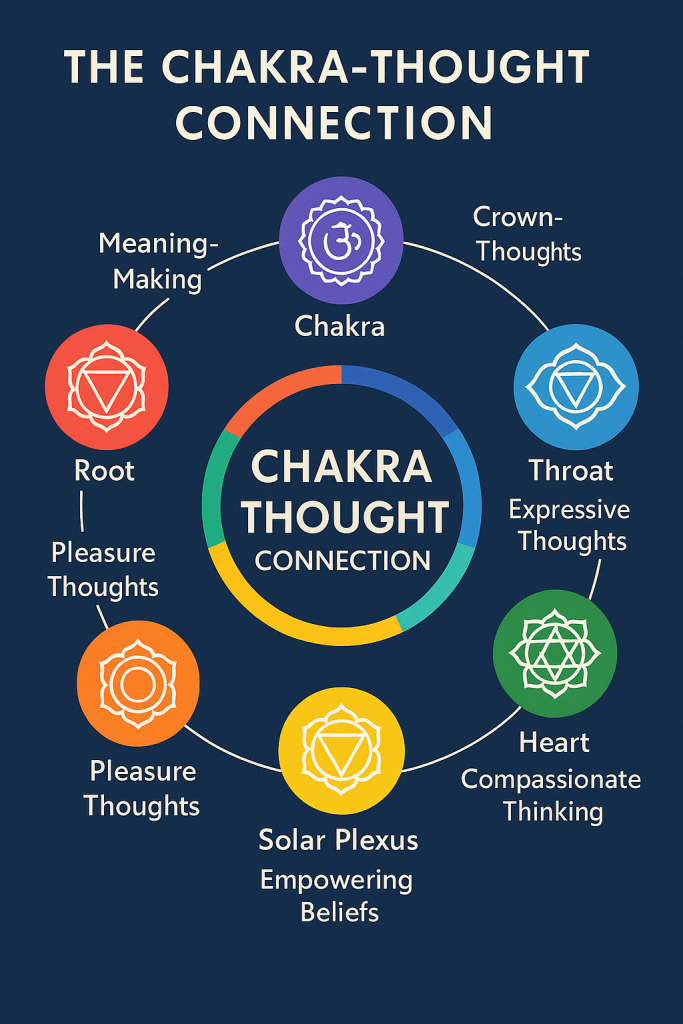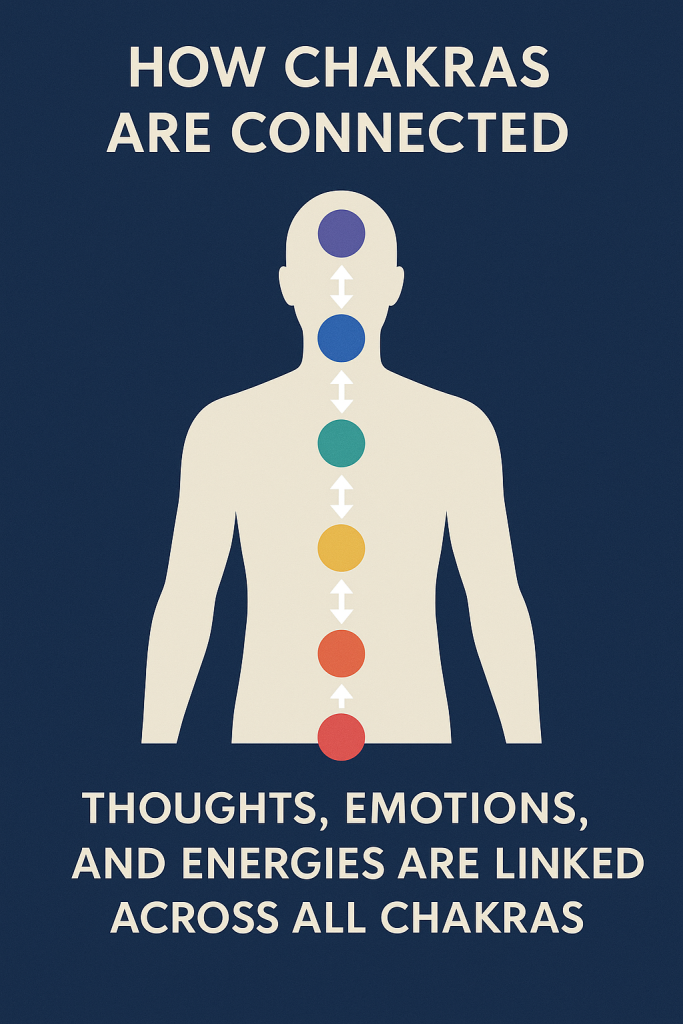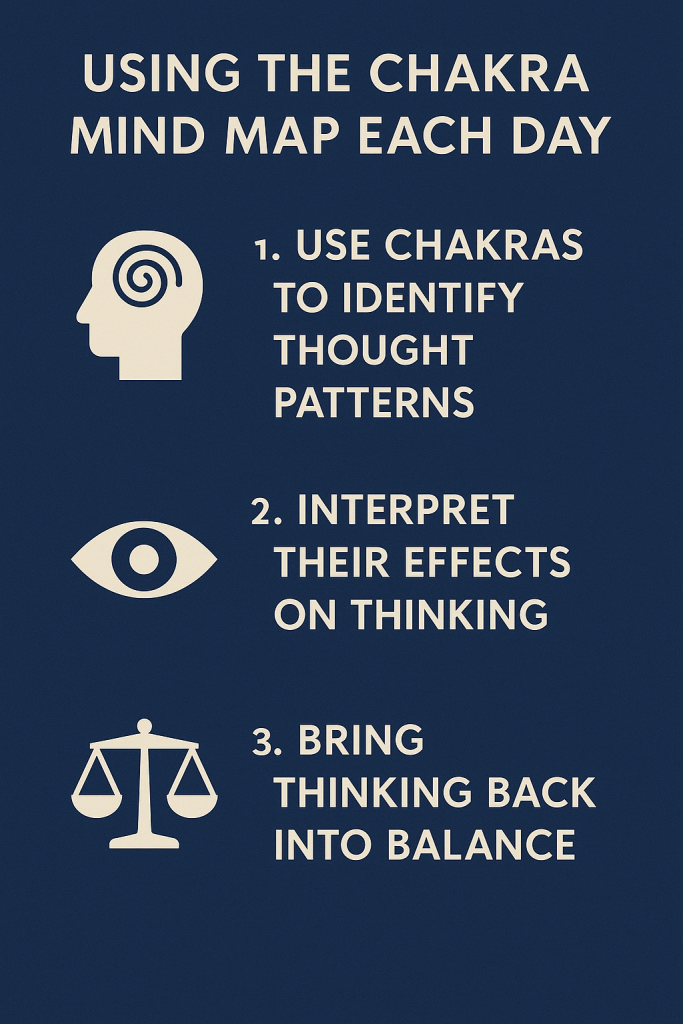Thought Isn’t Just a Busy Brain
People who think of thought think that this is just a busy brain where there are ideas that are forming, neurons going off, and worry moving around like clouds and electricity. Ancient healers, on the other hand, saw the mind as more than just matter but as a living energy field that works through every cell of the body. In this view, they believe that thoughts don’t just come in the brain but that they travel through the entire body, and they are shaped by subtle power, known as the chakras.
Most likely, you have felt a panic in your stomach before a big meeting or the warmth in your chest when someone tells you that they are proud of you. Some even feel a lump in their throat when they are trying to hold back tears. These aren’t just by chance, but they are physical sensations that happen with mental activity. Each thought, emotion, and belief vibrates throughout your energy spine.
The chakra system has its own makeup, and it is a place of thought. It is made up of seven major energy centers that run from the base of the spine to the crown of your head. Each of these has a different layer of consciousness. Modern psychology talks about how emotion and cognition work, and the chakra model helps people to see these experiences inside their bodies.
Scientists who study cognition and mindfulness are looking closer to ancient ideas. According to “Harvard Health Publishing,” they report that mindfulness and body awareness reduce stress and anxiety, which is measurable, and it is activated by regions of the brain that are responsible for empathy and regulation. When you notice how you breathe, you aren’t trying to escape thoughts, but you are rewiring your thinking and your responses. The chakras give you the intuitive framework for doing the same type of things with your energy by aligning the body, emotions, and mind into one coherent current.
Keep reading to see that this article isn’t about memorizing Sanskrit names or the colors of the chakra system, but it’s about seeing how each energy center shapes you. Think of the chakra system as a map of the mind and body, a place of understanding why habits, worries, and inspiration reach certain parts of your body.

Science and Spirit Meet
Research is starting to look at the body the way ancient healers always have, as an intelligent network where thought, emotion, and energy constantly interact. Scientists studying the brain, the nervous system, and the body’s natural electromagnetic fields are discovering that the mind doesn’t live in the head alone. The heart and the gut have their own clusters of neurons, which communicate directly with the brain and influence how we feel and respond to life.
Some call this connection the “body–mind loop,” which is a constant conversation inside you. Energy healers have their own language for it: they say the chakras are communicating.
Take the root chakra near the base of the spine. It connects to the physical systems that handle safety, like the adrenal glands and surrounding nerves. When life feels unstable or overwhelming, those systems go into alert mode and release stress hormones. You feel tense, closed off, like the ground is shifting beneath you. Energy practitioners understand this as the root chakra signaling a need for support and stability.
The heart chakra, on the other hand, aligns with the pathways that calm the nervous system, especially the vagus nerve. When you breathe slowly or feel genuine love, that nerve sends “all is well” messages to the brain. Scientists describe it as the parasympathetic system engaging. Energy healers describe the heart opening. They’re simply talking about the same shift through different lenses.
Research also shows that meditation changes the brain’s default settings, like loosening the grip of self-centered thinking and strengthening feelings of connection. In spiritual terms, that’s the crown chakra awakening to the bigger picture.
When you look at these models side by side, they don’t clash, but they complete each other. Science explains the mechanics. Spirituality explains the meaning. One talks about nerves and chemicals, the other talks about energy and intention. Together, they reveal a full map of human wellbeing.
Understanding your thoughts as energy makes self-care more intuitive. Instead of fighting every worry, you can notice where it lives in your body:
- Money stress might sit heavily at the base of your spine.
- Relationship worries may tighten the chest.
- Creative frustration could feel stuck in the stomach.
When you know where energy gets stuck, you also learn where it can be released. That’s what the chakra–mind system is all about: recognizing what your inner world is trying to say and helping it find ease again.
The Root Chakra or Muladhara
The root chakra is the foundation, and it’s what holds everything together. It is found at the base of the spine. This is the energy chakra that controls stability, security, and instinct that is needed to survive. When the root chakra is balanced, thoughts feel focused and steady, but when it’s blocked, thinking becomes suspicious, preoccupied with loss, and anxious.
The root chakra works with the color red, which is the color of blood and clay, and it shows groundedness and vitality. People who have a strong root energy seem to be more practical, structured, and more. They are people who plan, build, and save. They trust that life will take care of them because they know that they are anchored to the universe and not to fear.
When you aren’t certain about life, such as relationship problems, health problems, or when bills get hard, the mind goes into survival mode. This might sound like, “I’m on my own in this,” or “I’ll never be able to have enough.” This voice means that the root chakra isn’t balanced, and your mind is filled with mistrust.
You can do a grounding ritual to ensure that your thoughts are recalibrated. Go outside and take off your shoes. Put your feet into the dirt. As you breathe in, think of a red light coming to you from the ground up. Even though this sounds like a symbolic thing, it’s also biological. Studies show that a person who walks barefoot in the soil can help to lower cortisol levels and reduce inflammation. The root chakra doesn’t ground your energy, but it stabilizes your chemistry.
One client, who was a social worker, described how financial uncertainty caused her to have a mental tornado. Each morning, she would get up and think of the worst-case scenarios. She started doing a two-minute root reset before she would check her phone. She put her hand on her lower belly and said, “Right now, I am safe and grounded.” Within a week, she was able to have thoughts that were solution-oriented. The grounding energy helped her to have grounded thinking.
The Sacral Chakra: Creativity and Emotions
Just above the base of the spine is the sacral chakra, which is the center that fuels creativity, passion, and emotional connection. It’s associated with the color orange, a shade that reminds us of sunsets, citrus fruit, and all things alive and juicy. This chakra shapes how we experience delight, curiosity, and the urge to express ourselves, whether through art, movement, or deep connection with others.
When sacral energy moves freely, the mind feels playful and inspired. Thoughts drift in like waves, ideas feel exciting, and connection with others feels natural and easy. But when this energy gets stuck, the mind tightens. Joy becomes something to justify. Spontaneity turns into anxiety. You may start second-guessing anything that feels good, like worrying you’ll be judged or that pleasure must be “earned.”
This is a familiar struggle for creatives. A musician once shared that she could produce flawless music, but it lacked heart. Years of perfection pressure had squeezed the joy out of her creativity. We tried a simple shift; she promised to play each morning without recording, analyzing, or trying to impress anyone. Within weeks, the spark returned. She smiled and said, “My mind finally stopped censoring my heart.”
Modern research echoes what the chakra system teaches. Studies show that creative play and mindful movement can reduce stress and boost mood. By bringing attention to the hips and pelvis, like through dancing, stretching, or breathwork, we invite emotional softness back into the mind.
A balanced sacral chakra says, “Your feelings are allowed.” It reminds you that pleasure isn’t a luxury, but it’s a message. It shows you what feeds your spirit and what helps you stay alive inside. When your thoughts start sounding like rules with no room for joy, that’s your cue; your sacral energy needs a little love.
Solar Plexus or Manipura Chakra: Will and Identity
The Solar Plexus chakra is one that glows like the sun at noon. It is found right below the ribcage in the upper abdomen. It’s the place of confidence, motivation, and self-trust, and it says, “I can do it.”
When this chakra is balanced, the thoughts are organized and focused, and you can decide between your intuition and impulsive emotions. You can speak what’s on your mind, but not to control, but instead to have clarity.
If the Solar Plexus is unbalanced, you will have extreme feelings of self-doubt and overcontrol. You might even keep replaying mistakes in your mind and say things like, “I’m not good enough,” or you might say, “I have to control everything, or it will fall apart. Both of these things come from the fear of failure, and it makes things too dim or too bright.
People who are public speakers often have this kind of energy. Before they get on stage, they might have an experience where their stomach tightens, and these butterflies aren’t just nerves; but they are the Manipura chakra getting warm. One thing that coaches sometimes say is to try solar breathing, which means to inhale deeply and count to four and then hold, and then let it out completely. This lets the diaphragm expand, and it soothes the adrenal glands and turns anxiety and stress into focus.
One client talked about seeing a small sun radiating behind her belly button before she went to meetings. She said, “It sounds strange, but it gives me instant posture and mental sharpness.” This is her Solar Plexus chakra working and the energy turning into confidence and cognition.
When you look at energy psychology, it shows that this chakra also has boundaries. When you have a hard time over-giving or saying no to people, this can mean that your Solar Plexus is imbalanced. This might be from a fear of rejection, and you need to take time to rebalance this center and know that you are enough. This replaces guilt with power.
Heart Chakra: The Place of Unconditional Love
The lower chakras help us build who we are as individuals. The heart chakra is where we learn we’re not meant to stay isolated inside that identity. Positioned in the center of the chest and associated with a soft green glow, this chakra influences compassion, openness, and our ability to connect with others.
When this energy center is flowing well, the mind relaxes into generosity. You naturally give others the benefit of the doubt, notice small moments of beauty, and feel connected to the world around you. Thoughts move from self-protection into cooperation. Life feels kinder because you feel safe enough to be kind.
But when the heart energy tightens, the brain shifts into self-defense. You might tell yourself stories like, “I’m better off alone or caring only leads to disappointment.” The mind stops expanding and instead circles fear. Love becomes something to negotiate instead of something to feel.
A healer once told me, “Pay attention to how often someone says but.”
- “I care about them, but I can’t get hurt again.”
- “I want peace, but people never change.”
- The “but” is the mind building emotional armor.
Opening the heart isn’t about letting all boundaries disappear, but it’s about thinking in ways that include connection instead of excluding it.
Breathing into the chest and practicing gratitude are simple ways to reset this chakra. Deep breaths activate the nervous system’s calming pathways, helping the brain shift from anxiety into empathy. Research shows that feeling compassion changes neural activity, reminding us that love isn’t just a feeling, it’s a mode of thinking.
A therapist told me she begins each session by visualizing a green light glowing from her chest. She silently asks for understanding rather than judgment. She noticed her conversations became softer and more intuitive. “It’s less about being pleasant,” she said. “It’s about being present.”
The Throat Chakra: Speaking the Truth Clearly
If the heart guides how we feel toward others, the throat chakra helps us express that truth outwardly. Located in the neck and associated with calming shades of blue, this chakra supports honest speech, confident communication, and the courage to say what matters.
When throat energy flows freely, thoughts translate into words smoothly. You express yourself without overthinking or shrinking. You don’t need to convince because authenticity speaks for itself.
When this area is blocked, the mind gets tangled before the voice ever has a chance. You might rehearse conversations repeatedly, hold back opinions, or go quiet when your truth needs to come out. The physical body often participates, which is like a lump in the throat, a tight jaw, or the sense that words are stuck.
A writer once told me her ideas were vivid in her head but vanished the moment she tried to put them on a page. We added a small ritual: humming gently for a minute before she wrote. The vibration loosened her voice and slowed her mind. Soon, her creative flow returned, and no force was required.
The throat chakra’s purpose is expression, but its wisdom is in listening. When this chakra is overstimulated, words spill out too fast or too forcefully. True communication balances speaking and stillness. Silence can be a form of articulation, too.
Many studies reveal that mindful listening reduces emotional defensiveness and improves communication. In energy language, listening this way helps purify thoughts so what you speak reflects truth, not fear.
I like to call a blocked throat chakra a “spiritual sore throat,” which is the ache of swallowed ideas and unsaid dreams. Healing begins the moment you give yourself permission to sound like you again.
The Third Eye Chakra or the Ajan: Thoughts and Visions
The third eye chakra is found between the eyebrows. It is the place of imagination, inner knowing, and intuition. The color is indigo, and it has perception beyond what we can see with our eyes. If this were part of your mind’s lens, this chakra would have a focus of detail and meaning.
Having a balanced third eye means that your thoughts are logical and use intuition. You can look at a situation and analyze it without losing empathy, and you can follow a gut feeling without getting rid of reason. Insight is like recognition and not guessing. It’s a time that will just appear suddenly.
When this chakra is blocked, it causes spiritual tunnel vision. You might keep old beliefs or dismiss your intuition as a coincidence. When it’s in overdrive, it might cause overthinking, mental fog, or obsession with finding meaning in everything.
One business owner once said that they would brainstorm in an obsessive way, and they would write lists of pros and cons in everything they did. She said, “It wasn’t clarity, but it was fear that was wearing a planner.” She worked on short visualizations and meditation, and it allowed her purple glow to expand outward. As time went on, she was able to quiet her thinking, and it became clearer. She stopped planning and started perceiving.
Neuroscience today says a similar thing. According to “Scientific American,” they reported that meditation helps the brain to get stronger for pattern recognition and insight, and it quiets the default mode network, which is the same function that works with intuitive awareness in the spiritual world. Having a clear third eye doesn’t mean you get rid of logic, but you open up to it.
Balancing your third eye will teach you to trust the space between your thoughts and your knowing. This is where intuition will speak to you in a soft but truthful way.
The Crown Chakra or Sahasrara: Unity and Meaning
The crown chakra is found at the top of the head and has white and violet energy. It represents the consciousness. Where the root is about surviving and the heart is about love, the crown chakra says, “I am.”
Thoughts that come from the crown chakra are philosophical, connected, and expanded. They come when you look at the stars at night and when you feel small but infinite. They also show when you tear up with gratitude without knowing why. The crown chakra energy isn’t about religion, but it’s about a larger pattern.
When the crown chakra is blocked, you become cynical and narrow-minded. The mind focuses on outcomes and losses and forgets the mystery. Life becomes mechanical and without meaning. This chakra can be overactive as well, and this causes spiritual escapism where ideas come without grounding in your daily life. There has to be a balance of embodiment and humility that will bring inspiration and action.
A scientist talked about how she connected herself with her sense of purpose after she was facing burnout. She said, “I was buried in data but disconnected from why it mattered.” She started taking walks by the ocean at sunset and let her mind concentrate on the waves. She said, “It reminded me that science itself is sacred.” Her thought patterns went from cynicism to wonder, and this is how the crown chakra realigns.
In psychology, the crown chakra works with the pineal gland, and this is what regulates sleep and circadian rhythms. When life feels hard and chaotic, rest and natural light can open up this energy center. In the spiritual world, you can meditate, pray, and do good things that evoke awe inside of you.
When the crown chakra is balanced, it helps you see that your thoughts don’t define you, but there are many bigger things in the endless universe.
How Chakras Are Connected

Each chakra works with different mental patterns, and they form an energy that is peaceful and harmonizes, depending on what is going on inside of you. Having an imbalanced root chakra can mean that you have a fear of survival, and it can cause the third eye chakra to have paranoia. A closed heart chakra can cause your throat to close and take away your truth-speaking. The energy bodies talk to each other, and the chakras don’t work on their own.
Once you understand this, you will see that you need to have all of your chakras balanced to have holistic well-being. Instead of seeing a thought as something negative, say, “What part of me is really speaking?” and then see if you are reacting from fear in the root or perspective from the crown. Is your reaction from contraction or from expansion?
Energy healers and psychics often call this reading the current behind the thinking. This is the same thing as psychology working through somatic therapy and polyvagal theory, which shows how the body’s nervous system helps with cognition. The chakra system gives us a metaphor that says that each center has a voice, and each emotion is a signal. The goal isn’t to be quiet but to achieve peace.
You can practice opening your chakras by doing a chakra scan. Take time to sit quietly, take deep breaths, and imagine energy going from the root chakra to the crown chakra. As you focus on each chakra, you will see what kind of thoughts come to your mind. Are they creative or fearful? Judgmental or loving? Or are your thoughts visionary? As time goes on, you’ll start to see patterns. If you use these mental health habits, you will see that awareness helps you to start healing.
The Psychology of Chakras: Science and Spirit Connection
Psychotherapists are starting to look at the idea that thoughts are part of experiences. When someone has trauma, for example, it’s not only a living memory in the muscles, but it’s also in breath patterns and hormones. Chakra psychology goes even further with this and suggests that things like desire, confidence, fear, expression, intuition, and love have a place in the energetic body.
Someone who is a people pleaser might be working with an overactive heart chakra that combines with an underpowered solar plexus chakra. They have deep love for others, but they don’t set good boundaries. A client who has strong emotions might have an active third eye but a blocked sacral chakra. These energy dynamics bring compassion instead of criticism, and you aren’t broken; you just have imbalanced energy.
Therapists who use body-based mindfulness will guide clients to find out where a thought lives in their body before they analyze it. Having a heavy gut or a tight chest can mean one thing, while a buzz in the forehead means something else. These sensations work with the chakras and give an unspoken message. Healing isn’t as much about fixing the mind as it is about freeing the energies.
This kind of spiritual insight and cognitive science work together perfectly. Thoughts aren’t just neural firings in the brain, but they are frequencies that travel the same paths that carry emotions, awareness, and breath. When you balance these frequencies through meditation, movement, or visualization, it can change cognition more than reasoning alone does.
Using the Chakra Mind Map Each Day
You don’t have to memorize the chakras or mantras, but you can learn rituals that can help you to balance your chakras. The key is to be aware of what is going on in your energy. Here are some ways to ground yourself:
Grounding in the Morning for the Root Chakra
When you wake up, put both feet on the floor and take a deep breath. Say, “I am supported in my life.” Feel gravity helping you and not holding you down.
Having a Creative Flow for the Sacral Chakra
When you shower or you are driving, imagine an orange light going around your belly button. Ask yourself, “What would help make me joyful today?”
Looking At Your Confidence for the Solar Plexus Chakra
Before you do a task that’s important, take a deep breath into your stomach and imagine a small sun glowing brighter each time you breathe.
Communicating Honestly with the Throat Chakra
Before you go to a meeting, take time to touch your throat and breathe. Make an intention to speak the truth and don’t focus on perfection.
Resetting Intuition for the Third Eye Chakra
When you start overthinking, close your eyes and rest your attention on your eyebrows and the place between and say, “What is it I already know?”
Nighttime Reflection for the Crown Chakra
Before you go to sleep, imagine a soft violet light moving around your head. Show gratitude for being a human and for having energy.
These small rituals will help you to align your mental focus with your emotions in less than ten minutes a day. As time goes on, you will see that your thoughts will change from being scattered to being centered. They will go from fear to faith thoughts.
Some intuitive readers on reputable sites like PsychicOz.com use this same kind of process before they do a reading. They will look at their chakras and make sure that they are open and clear. Whether you are a psychic or not, this is a way to make your intuition stronger and to quiet your brain chatter.

Final Thoughts: Chakras that Shape the Mind
Thoughts are the most personal energy that you have. They help you to make choices, to write stories, and to have an identity. They are responsive, fluid, and deeply embodied. The chakra system helps you to understand the part of living as a breathing ecosystem, and not about controlling the mind.
When your energy flows and isn’t blocked, it becomes creative instead of reactive. The decisions that you make will feel inspired and not pressured. Love makes you feel safe and isn’t conditional. You don’t have to transcend to be a human being, but you just need to tune into your vibrational frequencies.
From the root chakra that brings calm to the Muladhara that helps you to transcend to the Sahasrara that gives you peace, each of these chakras shows you that real wisdom isn’t about living in your head but with every heartbeat, breath, and spark of awareness that goes through you.
FAQ
What is a chakra mind map?
A chakra mind map is a visual way to connect each energy center to the dominant thoughts, emotions, and behaviors it tends to influence.How do chakras affect thought patterns?
Each chakra corresponds to certain cognitive themes—safety, pleasure, power, love, expression, insight, and meaning—which shape automatic thoughts and decisions.Can blocked chakras cause mental fog?
Yes. Stagnation in any chakra can correlate with repetitive thoughts, indecision, or brain fog around that chakra’s life theme.Which chakra most affects self-talk?
The solar plexus (Manipura) shapes inner dialogue about worth, capability, and personal power.How do I know if my root chakra affects my thinking?
If survival worries, financial fear, or hypervigilance dominate your thoughts, your root chakra may need grounding.What thought patterns signal a sacral chakra imbalance?
All-or-nothing pleasure thinking, shame around desire, or creative droughts often reflect sacral disharmony.What are common solar plexus thought traps?
Perfectionism, impostor syndrome, catastrophizing outcomes, and over-control are frequent solar plexus traps.How does the heart chakra shift cognition?
It softens harsh judgments, increases empathy, and reframes conflicts through compassion and connection.Can throat chakra work improve overthinking?
Yes. Clear expression reduces rumination by turning looping thoughts into articulated plans and boundaries.What thinking errors relate to the third eye?
Tunnel vision, ignoring intuition, and over-indexing on data while dismissing gut insight can signal third-eye imbalance.How does the crown chakra influence mindset?
It frames meaning: existential trust, spiritual perspective, and the ability to hold paradox without mental strain.Do chakras relate to cognitive biases?
They can. For example, root fear may amplify negativity bias, while solar plexus pride may fuel confirmation bias.What daily practice aligns chakras and thoughts?
A 7-minute stack: 1 minute per chakra with breath, attention to its theme, and one tiny aligned action.How can I map my recurring thoughts to chakras?
List your top three recurring thoughts, locate the matching chakra theme, note triggers, then design one corrective micro-habit per theme.Which chakra is best for decision clarity?
Third eye for pattern recognition and inner cues; solar plexus for confident action; together they support decisive clarity.Can heart chakra work improve conflict resolution?
Yes. Heart-centered reframes (“us vs. the problem”) reduce blame and open collaborative problem-solving.What’s a quick reset when anxiety spikes?
Root-down: exhale twice as long as you inhale, feel your feet, name five physical sensations, then choose one next step.How do I use affirmations by chakra?
Write one “state + behavior” line per chakra, e.g., “I am supported, so I budget today” (root) or “I am clear, so I speak up once” (throat).Can movement change thought loops?
Yes. Somatic inputs—walking for root, hip mobility for sacral, core work for solar plexus—often interrupt mental spirals.How does journaling fit a chakra mind map?
Use seven prompts weekly, one per chakra, to translate sensations and emotions into specific, value-aligned actions.What signals balanced root-level thinking?
Practical plans, steady pacing, and realistic risk assessment without doom-spiraling.What signals balanced sacral-level thinking?
Flexible thinking about pleasure, creativity, and relationships without guilt or compulsivity.What signals balanced solar plexus thinking?
Self-trust, timely decisions, and accountability without harsh self-attack.What signals balanced heart-level thinking?
Nuanced interpretations of others’ motives and self-compassion during mistakes.What signals balanced throat-level thinking?
Direct, timely communication and the courage to say no or ask for clarity.What signals balanced third-eye thinking?
Synthesis: seeing patterns, weighing data with intuition, and tolerating uncertainty.What signals balanced crown-level thinking?
Perspective: meaning-making, gratitude, and the ability to pause before reacting.How often should I revisit my chakra mind map?
Weekly check-ins work well; update after major life changes or emotional spikes.Can chakra work support therapy or coaching?
Yes. It offers a body-mind framework that complements cognitive tools and goal-setting.What’s the fastest way to start today?
Pick the most active theme, do a 90-second breath-and-body cue for that chakra, and take one tiny aligned action.





This article turned me into a human disco ball 🌈✨ Apparently I’m just one blocked chakra away from enlightenment! Next time my boss annoys me, I’ll tell him my solar plexus is misaligned instead of flipping out 🔥
I think it’s fascinating how stress and emotion can affect different parts of our body. The throat chakra example really spoke to me—I always get that lump when I’m holding something back. Makes me want to explore this more!
Man, this chakra stuff makes a lotta sense now. I used to think it was just hippy talk but the way they explain how your gut or chest feels things? That’s real! I feel that all the time. I ain’t got fancy words for it, but now I know my stomach ain’t just about food—it’s feelings too. Gonna try walking barefoot more now.
While I do appreciate the metaphorical richness of chakras, claiming that unblocking them can solve mental fog seems reductive. Mental health is multifaceted—yes, emotions live in the body—but let’s not oversimplify by attributing every thought pattern to energy centers.
‘Energy fields through every cell’? Sure… and unicorns manage your Wi-Fi signal too. This article reads like someone binge-watched Avatar: The Last Airbender during a mushroom trip.
@Chump Honestly, you say that sarcastically but there’s actually evidence around bioenergetics and electromagnetic fields interacting with neural function. So maybe dig deeper before mocking?
‘When your thoughts sound like rules with no joy’—that hit me hard 😢 I’ve been stuck in overthinking mode lately and never thought to check where those feelings sit in my body. Gonna start those mini rituals ASAP.
I don’t buy this new-age fluff for one second. Chakras? Really? Sounds like someone swallowed a yoga mat and started writing. There’s science, and then there’s fantasy dressed up in science-y words. Let’s not pretend chanting and colors will replace real therapy or medicine.
While the article is well-written and thoughtful, I feel it lacks critical thinking around cultural appropriation. Using Eastern spiritual systems without discussing their origins or respecting traditional practice feels incomplete.
Wow, so now my stomachache is apparently my chakras crying? I’m not buying it. Sounds like pseudoscience wrapped in sparkly language. Real medicine looks at data, not ‘orange light around your belly button.’
*Really* appreciated how the piece doesn’t demand perfection—just awareness. As someone who struggles with anxiety loops, knowing that each thought has an ‘energy place’ gives me something actionable to focus on when everything feels overwhelming.
This article is a beautiful integration of ancient wisdom and modern science. I appreciate how it bridges Eastern chakra philosophy with neuroscience, especially the explanation of how emotions manifest physically. As a yoga teacher, this will be helpful for my students.
Oh great, so now my bad mood isn’t just PMS or stress—it’s my sacral chakra throwing a tantrum 🙄 What’s next? Horoscope therapy? Maybe Mercury in retrograde is why I burned dinner too!
‘Thoughts are energy’—so does that mean I can charge my phone with anxiety? 😜 Cool if true, but let’s not pretend humming fixes writer’s block.
Fascinating synthesis of ancient wisdom and contemporary neuroscience. This article bridges somatic psychology with energetic frameworks in a compelling way. The integration of vagus nerve research with chakra archetypes is particularly insightful for trauma-informed therapeutic models.